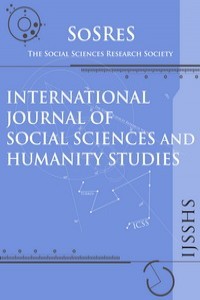THE INTERNATIONAL STUDENTS’ PERCEPTION TOWARDS THE EDUCATION QUALITY
THE INTERNATIONAL STUDENTS’ PERCEPTION TOWARDS THE EDUCATION QUALITY
International Education, Service, Quality,
___
- A. Parasuraman, Leonard L. Berry and Valarie A. Zeithaml (1988), “SERVQUAL: A Multiplie Item Scale for Measuring Customer Perception of Service Quality”, Journal of Retailing, Vol. 64, No. 1, pp. 12-40.
- Albert Caruana, Arthur H. Money and Pierre R. Berthon (2000), “Service Quality and Satisfaction-the Moderating Role of Value”, European Journal of Marketing, Vol. 34, No. 11/12, pp. 1338-1352.
- Asghar Afshar, Mohammad Ali, and Seyed Abbas (2011), “Study the Effects of Customer Service and product Quality on Customer Satisfaction and Loyalty”, International Journal of Humanities and Social Science, Vol. 1, No.7, pp. 253- 260.
- Beverly K. Khan, Diane M. Strong, and Richard Y.Wang (2002), “Information Quality Benchmarks: Product and Service Performance”, Communications of the ACM, Vol. 45, No. 4.
- Brenda M. Oldfield and Steven Baron (2000), “Students' Perception of Service Quality in a UK University Business and Management Faculty”, Quality Assurance in Education, Vol. 8, No. 2, pp. 85.
- Giese L. John and Cote A. Joseph (2002), Defining Consumer Satisfaction. Academy of Marketing Science Review, 2000(1).
- GS Sureshchandar, Chandrasekharan Rajendran and R.N. Anantharaman (2002), “The Relationship Between Service Quality and Customer Satisfaction- A Factor Specific Approach”, Journal of Service Marketing, Vol. 16, No.4, pp. 363-379.
- Hamidah Abdul Rahman, Zainab Khalifah, Shoki Arif, Rosnah Sirin, Hafilah Zainal Abidin and Norzarina Sulong (2004), Kajian Mengenai Tahap Kualiti Pendidikan Tinggi dari Perspektif Pelajar di Universiti Teknologi Malaysia. Vote 75017.
- Kah-Hin Chai, Yi Ding, and Yufeng Xing (2009), Quality and Customer Satisfaction Spillovers in the Mobile Phone Industry Service Science, Vol. 1, No.2, pp.93-106.
- Ken Clarke (2001), “What Price on Loyalty When a Brand is Just a Click Away?”, Qualitative Market Research: An International Journal, Vol. 4, No. 3, pp. 160-168.
- Leon G. Schiffman and Leslie Lanzar Kanuk (2000), Consumer Behavior. International. Inc.: Prentice-Hall.
- Mercedes Marzo Navarro, Pedraja Iglesias and Pilar Rivera Torres (2005), “A New Management Element of Universities: Satisfaction with the Courses Offered”, International Journal of Education Management, Vol. 19, No. 6, pp. 505-526.
- Miller E. Robert and Nita G. Brooks (2010), “Class Service Quality: Moving Beyond SERVQUAL”, Information Systems Educators Conference, Vol. 27, No. 1394.
- Mubbsher Munawar Khan, Ishfaq Ahmad and Muhammd Musarrat Nawaz (2011), “Student's Perspective of Service Quality in Higher Learning Institutions: An Evidence Based Approach”, International Journal of Business and Social Science, Vol. 2 No.11, pp. 159-164.
- Oyvind Helgesen and Erik Nesset (2007), “What Accounts for Students' Loyalty? Some Field Study Evidence”, International Journal of Education Management, Vol. 21, No. 2, pp. 126-143.
- Rudolf Kruse, Matthias Steinbrecher and Christian Moewes (2010), “Data Mining Applications in the Automotive Industry”, 4th International Workshop on Reliable Engineering Computing.
- Sik Sumaedi and Gede Mahatma Yuda Bakti (2011), “The Students' Percieved Quality Comparison of ISO 9001 and Non-ISO 9001 certified School: An Empirical Evaluaiton”, International Journal of Engineering & Technology IJET- IJENS, Vol.11, No.1, pp. 104-108.
- Wayney D. Hoyer and DJ MacInnis (2001), Consumer Behavior. Boston: Houghton Mifflin Company.
- Başlangıç: 2009
- Yayıncı: Sosyal Bilimler Araştırmaları Derneği
QUALITY FUNCTION DEPLOYMENT AS A STRATEGIC PLANNING TOOL
Burcu DEVRİM İÇTENBAŞ, Hande ERYILMAZ
UNDERGRADUATE STUDENT’S SATISFACTION TOWARD THE NEW EDUCATION SYSTEM IN THAILAND
THE ROLE OF MUSIC IN THE NATIONAL-BOLSHEVIK ORGANIZATION: A WEB-BASED ANALYSIS
THE COMPETITION/COOPERATION RELATIONSHIP IN EXECUTIVE POWER OPERATING OF SEMI-PRESIDENTIALISM
CONSTITUTIONAL ECONOMICS, FISCAL POLICY RULES, AND THE CASE OF TURKEY
Osman Nuri ARAS, Mustafa ÖZTÜRK
TOWARDS SUSTAINABLE ENTREPRENEURIAL PRACTICES IN SOUTH AFRICA: SELECTED CASE STUDIES
EUROPEAN-TURKISH IDENTITY INTERACTION FROM THE SOCIAL CONSTRUCTIVIST PERSPECTIVE
A SOCIOLOGICAL EVALUATION OF HOME-BASED WORKING AND WOMAN LABOUR
